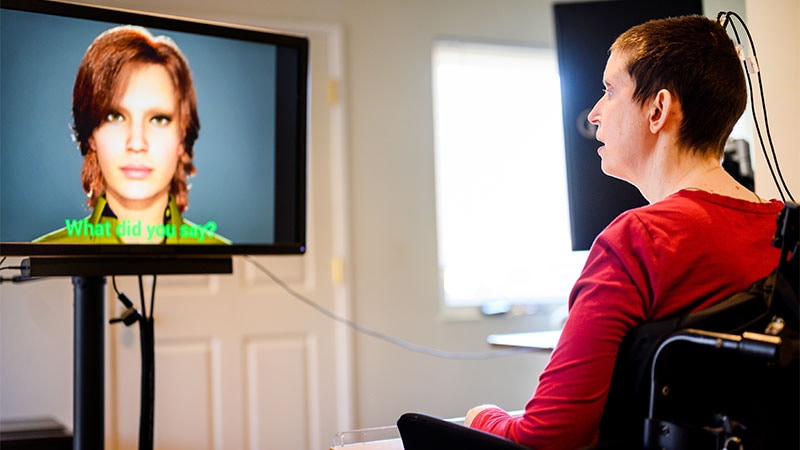Artificial Intelligence Enables Paralyzed Woman to Speak Through Avatar
Alapfogalmak
AI enables paralyzed woman to communicate through digital avatar, revolutionizing speech synthesis.
Kivonat
The content discusses a breakthrough in healthcare technology where a paralyzed woman, unable to speak due to a brainstem stroke, regains her ability to communicate through a brain-computer interface (BCI) and a digital avatar. Key highlights include:
- Researchers at UCSF and UC Berkeley achieve speech and facial expression synthesis from brain signals.
- The technology aims for full human speech embodiment beyond words.
- The research marks a significant milestone towards aiding paralyzed individuals.
- Neural signals are translated into audible synthetic speech and facial movements.
- Deep-learning models are trained using neural data to recognize speech patterns.
- An algorithm synthesizes speech and simulates facial movements for the avatar.
- The research introduces a multimodal speech-neuroprosthetic approach for severe paralysis.
- Future steps include developing a wireless version for enhanced user independence.
Összefoglaló testreszabása
Átírás mesterséges intelligenciával
Hivatkozások generálása
Forrás fordítása
Egy másik nyelvre
Gondolattérkép létrehozása
a forrásanyagból
Forrás megtekintése
www.medscape.com
Artificial Intelligence Gives Paralyzed Woman Voice Back
Statisztikák
"In this new study, our translation of attempted speech into text reach about 78 words per minute."
"The team implanted a paper-thin rectangle of 253 electrodes onto the surface of the woman's brain over areas critical for speech."
"For weeks, she repeated different phrases from a 1024-word conversational vocabulary over and over again, until the computer recognized the brain activity patterns associated with the sounds."
Idézetek
"Our goal in incorporating audible speech with a live-action avatar is to allow for the full embodiment of human speech communication, which is so much more than just words." - Edward Chang, MD
Főbb Kivonatok
by Megan Brooks : www.medscape.com 08-23-2023
https://www.medscape.com/viewarticle/artificial-intelligencegives-paralyzed-womanher-voice-back-2023a1000joi
Mélyebb kérdések
How can this technology impact the lives of paralyzed individuals beyond communication?
This technology has the potential to significantly improve the quality of life for paralyzed individuals in various ways beyond communication. For instance, it can enhance their independence by allowing them to control computers and phones wirelessly, giving them more autonomy in their daily activities. Moreover, the ability to interact with digital avatars through brain-computer interfaces can open up opportunities for paralyzed individuals to engage in virtual environments, participate in social interactions, and potentially even operate robotic devices or prosthetics. Overall, this technology has the potential to empower paralyzed individuals and enhance their overall well-being and social integration.
What ethical considerations should be taken into account when implementing such advanced technologies?
When implementing advanced technologies like brain-computer interfaces for paralyzed individuals, several ethical considerations must be taken into account. Firstly, issues related to privacy and data security arise, as the technology involves accessing and interpreting sensitive neural data. Safeguards must be in place to protect the confidentiality and integrity of this information. Additionally, informed consent is crucial, ensuring that individuals fully understand the risks and benefits of using such technology. Furthermore, questions about autonomy and agency come into play, as the technology involves interpreting and translating neural signals, raising concerns about who has control over the individual's thoughts and actions. Ethical guidelines and regulations should be established to address these complex ethical issues and ensure the responsible development and deployment of these technologies.
How might this breakthrough in AI and healthcare technology influence the future of human-computer interactions?
This breakthrough in AI and healthcare technology has the potential to revolutionize human-computer interactions in various ways. By enabling individuals to communicate and interact with digital avatars through their brain signals, it opens up new possibilities for more intuitive and immersive interfaces. This technology could lead to the development of more advanced assistive technologies for individuals with disabilities, allowing for more natural and efficient ways of interacting with computers and devices. Furthermore, it could pave the way for the integration of AI-driven systems in healthcare settings, enabling more personalized and responsive care for patients. Overall, this breakthrough has the potential to transform the way humans interact with computers, making interactions more seamless, intuitive, and inclusive.
0
